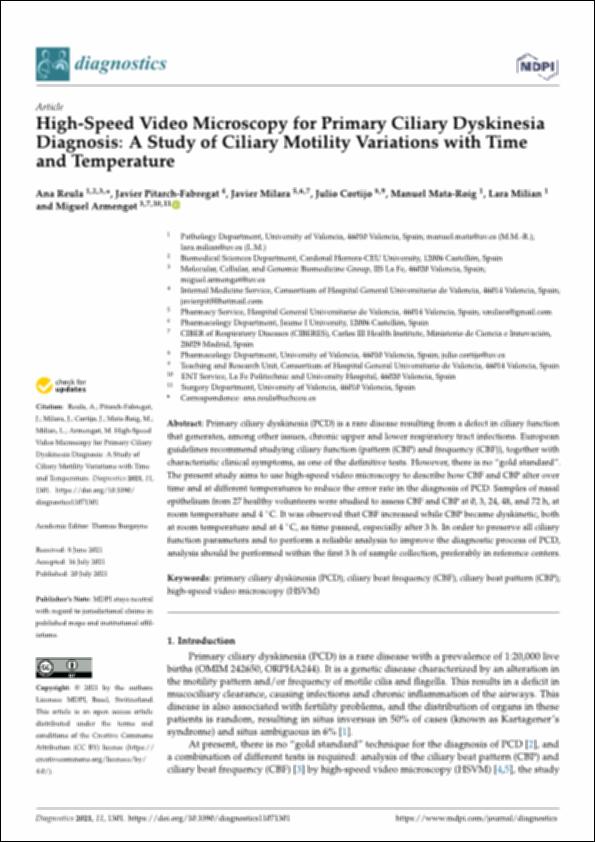Please use this identifier to cite or link to this item:
http://hdl.handle.net/10637/13609High-speed video microscopy for Primary Ciliary Dyskinesia diagnosis : a study of ciliary motility variations with time and temperature
| Title: | High-speed video microscopy for Primary Ciliary Dyskinesia diagnosis : a study of ciliary motility variations with time and temperature |
| Authors : | Reula Martín, Ana Pitarch Fabregat, Javier Milara, Javier Cortijo Gimeno, Julio Mata Roig, Manuel Milian Medina, Lara Armengot, Miguel |
| Keywords: | Microscopy.; Microscopia.; Kartagener, Síndrome de - Diagnóstico.; Kartagener's syndrome - Diagnosis.; Primary ciliary dyskinesia - Diagnosis.; Aparato respiratorio - Enfermedades en los niños.; Pediatric otolaryngology.; Otorrinolaringología pediátrica.; Enfermedades crónicas en los niños.; Respiratory organs - Diseases in children.; Chronic diseases in children.; Disquinesia ciliar, Síndrome de - Diagnóstico. |
| Publisher: | MDPI |
| Citation: | Reula, A., Pitarch-Fabregat, J., Milara, J., Cortijo, J., Mata-Roig, M., Milian, L. & Armengot, M. (2021). High-speed video microscopy for Primary Ciliary Dyskinesia diagnosis: a study of ciliary motility variations with time and temperature. Diagnostics, vol. 11, i. 7 (20 jul.), art. 1301. DOI: https://doi.org/10.3390/diagnostics11071301 |
| Abstract: | Primary ciliary dyskinesia (PCD) is a rare disease resulting from a defect in ciliary function that generates, among other issues, chronic upper and lower respiratory tract infections. European guidelines recommend studying ciliary function (pattern (CBP) and frequency (CBF)), together with characteristic clinical symptoms, as one of the definitive tests. However, there is no “gold standard”. The present study aims to use high-speed video microscopy to describe how CBF and CBP alter over time and at different temperatures to reduce the error rate in the diagnosis of PCD. Samples of nasal epithelium from 27 healthy volunteers were studied to assess CBF and CBP at 0, 3, 24, 48, and 72 h, at room temperature and 4 C. It was observed that CBF increased while CBP became dyskinetic, both at room temperature and at 4 C, as time passed, especially after 3 h. In order to preserve all ciliary function parameters and to perform a reliable analysis to improve the diagnostic process of PCD, analysis should be performed within the first 3 h of sample collection, preferably in reference centers. |
| Description: | Este artículo se encuentra disponible en la siguiente URL: https://www.mdpi.com/2075-4418/11/7/1301 Este artículo de investigación pertenece al número especial "Progress in Diagnosing and Managing Primary Ciliary Dyskinesia". |
| URI: | http://hdl.handle.net/10637/13609 |
| Rights : | http://creativecommons.org/licenses/by/4.0/deed.es |
| ISSN: | 2075-4418 (Electrónico) |
| Issue Date: | 20-Jul-2021 |
| Center : | Universidad Cardenal Herrera-CEU |
| Appears in Collections: | Dpto. Ciencias Biomédicas |
Items in DSpace are protected by copyright, with all rights reserved, unless otherwise indicated.


